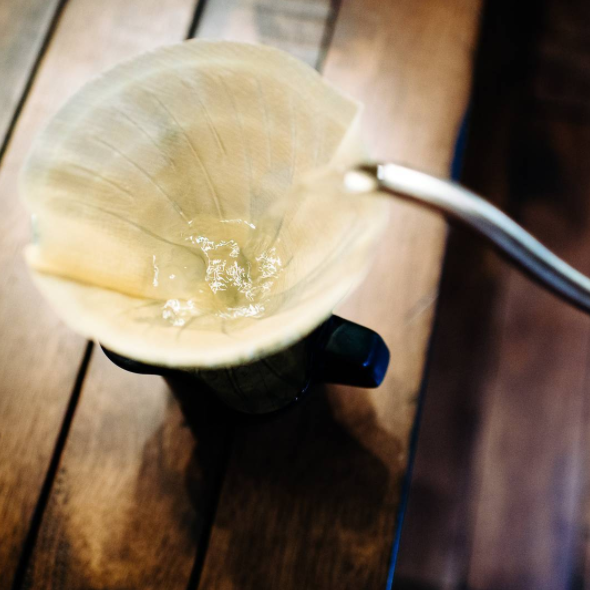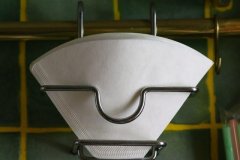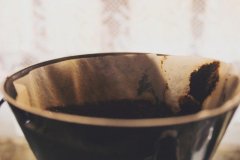Is American coffee filter paper harmful after bleaching? Introduction of three bleaching processes for bleaching filter paper

Professional coffee knowledge exchange more coffee bean information please follow the coffee workshop (Wechat official account cafe_style)
Which filter to choose for hand-brewed coffee: comparison of filter paper, metal filter mesh and filter cloth
Coffee conditioning equipment and methods are varied, but when it comes to "easy to use", "cheap" and "brewing quality", there is probably no one comparable to hand-brewed coffee with a combination of filter cups and filter paper. However, users of filter cups and filter paper often face a little confusion: there are almost two different filter papers for the same type of filter cup, such as Hario V60, one is unbleached tan filter paper, the other is bleached white filter paper, which one should be chosen? I would like to make a brief introduction so that readers can have a reference in their choice.
The raw material of filter paper is wood. After the process of fine cutting and cooking, the preliminary pulp is obtained. At this time, the pulp is similar to the original wood in color or smell, that is, it is close to yellowish brown and has a strong wood smell. If you use this kind of pulp to make coffee filter paper, the color is still secondary, but the smell is bound to affect the brewed coffee, so we must go through some processes to reduce the smell of the paper.
How to reduce the smell of paper? There are two main methods, the first is not bleaching, but increase the number of washing, the second is the use of chemicals to bleach the pulp, bleaching process at the same time to eliminate most of the smell, further explained as follows.
Let's start with unbleached filter paper. The smell of paper comes from lignin. The cheapest and most effective way to reduce the smell is to use chemicals, on the one hand, to bleach (white paper has many uses) and on the other hand to eliminate most of the smell. However, chemicals will more or less harm the ecological environment, if you want to reduce both odor and chemical use, you can only spend more time in the manufacturing process to wash the pulp. therefore, the labor cost and time cost are higher than those of using chemicals. this is why the price of unbleached filter paper is usually higher.
If you look at the bleached filter paper, it can be divided into three categories according to different bleaching processes:
Traditional bleached filter paper
The traditional bleaching method is the use of chlorine, which is highly toxic. In the 1980s, it aroused doubts about its safety in the coffee industry. Later, it was found that there was no toxic residue and it was not dangerous to brew coffee with bleached filter paper. However, the waste water produced by chlorine in the production process will seriously pollute the environment and pose a great threat to human health [Note 1]. At present, this kind of filter paper made by traditional bleaching is rare on the market, but it is best to confirm it before you buy it.
Acid bleached filter paper
That is, the filter paper is bleached with oxygen. The chemicals used in the bleaching process are mainly oxygen, hydrogen peroxide, ozone, baking soda, chlorine dioxide, etc., this paper-making process greatly reduces the damage to the environment (not without it at all). Because it modifies the use of chlorine in the first stage of the traditional process, although chlorine-containing compound chlorine dioxide is still used, chlorine dioxide is a very good oxidant in chemical reactions. Toxic chlorides are not formed by substitution, as is the case with chlorine. Nowadays, most of the bleached filter paper on the market belongs to this kind, especially the products of well-known brands, such as Hario, Kono and so on.
Enzyme bleached filter paper
Enzyme bleaching is a quite new paper-making method, which has been developed for no more than 20 years. I have a lot of doubts about this kind of bleached filter paper. I once asked an old classmate who was familiar with making paper and was a senior director of the largest pulp mill in China before retiring. According to him, no domestic paper factory has used this new method, except that the general process is to replace oxygen with xylanase (Enzymes), which is centrifuged, screened, filtered, salted out, solvent precipitated, re-filtered and spray-dried. A series of procedures such as freeze-drying to obtain enzyme extracts that can be used for bleaching and then add them to the final stage of pulping. It is said that this method of making paper produces less harmful substances than acid bleaching. However, it is regrettable that there seems to be no sign of enzyme bleaching filter paper in Taiwan. Although HarioV60 filter papers, known as enzyme bleaching, are sold on the Internet, they asked the Taiwan agents of Hario, and they replied that at present, all Hario bleached filter papers are acid bleached filter papers.
So, should we choose unbleached filter paper or bleached filter paper? If readers are so confused, please take a look at my advice to members of the May 4th Coffee Club:
Whether it is bleached or unbleached filter paper, the smell of paper is inevitable, and the difference is only in the weight. Generally speaking, bleached filter paper tastes light, but does more harm to the environment; unbleached filter paper is less harmful to the environment, but the smell of the paper is heavier. If you pay attention to the ecological environment, it is recommended to choose large brands, high-quality unbleached filter paper; if you think coffee flavor is more important, then choose bleached filter paper, but only choose acid bleaching or enzyme bleaching filter paper, at least reduce the damage to the environment. In addition, before brewing coffee, fully wet filter paper is also a good way to reduce paper flavor, especially unbleached filter paper, paper flavor reduction is particularly obvious. Wetting filter paper with hot water has two other advantages:
(1) enable the filter paper to be affixed to the filter cup
(2) warm the container below by the way.
With regard to filter paper, in fact, there are also some factors worth paying attention to, such as texture, thickness, shape of filter paper and so on, which will affect the filtering effect and bring subtle differences to coffee, but the research in this area has not been concluded yet, so this paper has to stop here.
[note 1] the bleaching process includes chlorination and alkali extraction, which requires the use of a variety of chemical substances such as hypochlorite, chlorine dioxide, oxygen, ozone, hydrogen peroxide, etc.; the resulting waste liquid contains AOX (adsorbable organic halogen), that is, chlorine-containing organic substances collectively referred to as "adsorptive organic halides". AOX is composed of chlorinated derivatives of benzene, biphenyl, phenol, catechol and guaiacol, which can be divided into high molecular weight AOX and low molecular weight AOX. Among them, high molecular weight AOX is not easy to lead to the increase of mutagenicity because of its low biological activity and low toxicity, but low molecular weight AOX is easy to penetrate into the fine cell membrane because of its low molecular weight and hydrophobicity, which is the main reason for the increase of gene mutation (mutagenecity) and bioaccumulation (bioaccumulation), especially the aquatic organisms at the top of the food chain (aquatic food chain) will accumulate a higher amount in body fat. In addition, various chlorinated derivatives have different toxicities, for example, exposure to 60 ppm chlorobenzenes may cause headaches, eye inflammation, throat ulcers and other symptoms. It has been confirmed that chronic exposure to chlorobenzene is easy to cause lung disease, renal function degradation and purpura (porphyria). Chlorobenzene affects the central nervous system, causing dizziness, hypersensitivity (hyperesthesia) and muscle spasm (musclespasms), while hexachlorobenzene is known to cause cancer in animal experiments.
[note 2] oxygen is called acid in Japanese. When it comes to "oxidation" in Chinese, it is called "acidification" in Japanese, because oxidation produces acidic substances, which is the Japanese perception of oxygen. Taiwan has a long history with Japan, and many things have the same name. "Acid bleaching" is a case in point.
.
Important Notice :
前街咖啡 FrontStreet Coffee has moved to new addredd:
FrontStreet Coffee Address: 315,Donghua East Road,GuangZhou
Tel:020 38364473
- Prev

How to use coffee filter paper? Comparison of the effects of different brands of coffee filter paper on coffee flavor
Professional coffee knowledge exchange more coffee bean information please pay attention to the coffee workshop (Wechat official account cafe_style) hand-brewed coffee filter to choose which kind: filter paper, metal filter screen, filter cloth comparison of filter paper on coffee comparison as a lover of hand-brewed coffee, to brew a good cup of coffee, you must first understand the characteristics of coffee beans, and then choose brewing methods and methods that can give full play to their characteristics.
- Next

How to fold the coffee filter paper? Is it better to bleach coffee filter paper or not to bleach the raw pulp?
Professional coffee knowledge exchange more coffee bean information Please follow the coffee workshop (Wechat official account cafe_style) hand-brewed coffee filter which kind to choose: filter paper, metal filter, filter cloth comparison coffee filter paper is only a small element of a good cup of coffee, but if you like to use a filter that requires filter paper to make coffee, do you want to buy bleached or unbleached coffee? How to avoid brewing coffee
Related
- What is the Philharmonic pressure? How to use Philharmonic pressure to make delicious coffee
- Why does a hand grinder have more fine powder than an electric grinder?
- In addition to the hot mom, what is the difference between the versions of EK43 | ditting and Mahdi ek43?
- What kind of equipment do you need to make coffee by hand? Introduction to novice starter cooking equipment tools
- Espresso needs to be ground how thick and thin scale entry Italian Coffee Machine Bean Grinder investigation and Grinding course
- How much does it cost to open a small private cafe? How much does it cost to learn coffee? How to operate it?
- The difference between the flavor characteristics of hand-brewed coffee and coffee maker is hand-brewed coffee really better than coffee maker? Can I use a coffee machine to make coffee beans by hand?
- The difference between 01 and 02 of hario v60 filter cup what is the difference between 01 and 02 filter cup opening and cooking flavor
- What's the difference between the smart cup and the French kettle? Which is better, the French kettle or the Smart Cup?
- What's the difference between a smart cup and a V60 filter cup? The difference between the taste of smart cup and hand-brewed coffee

